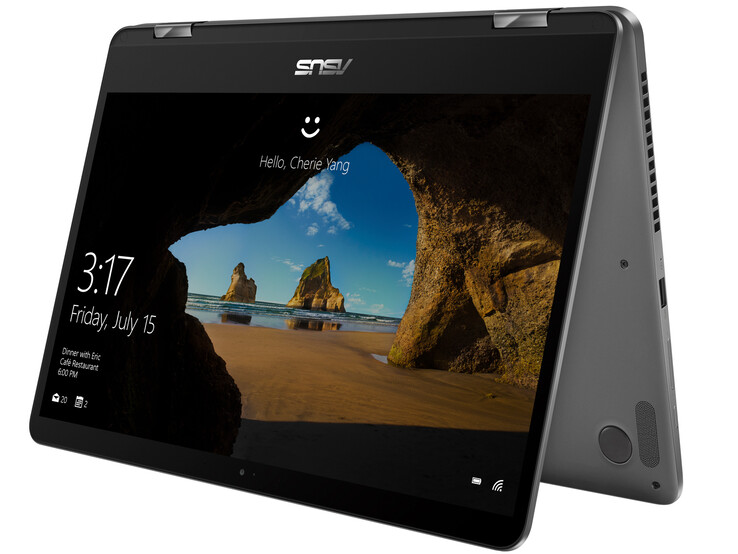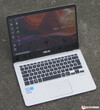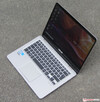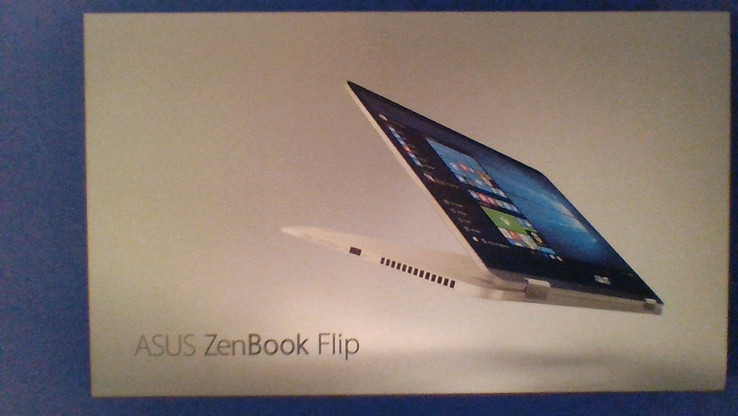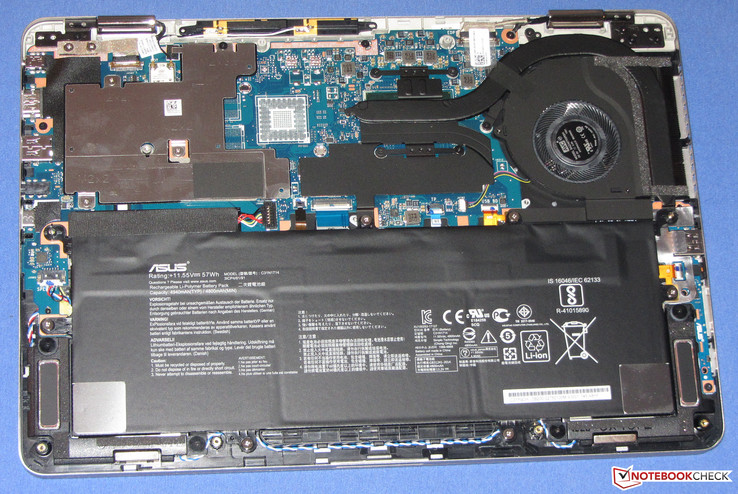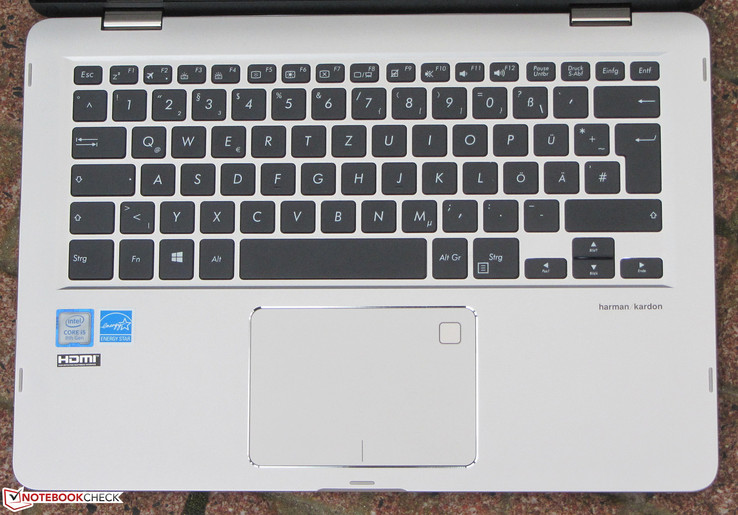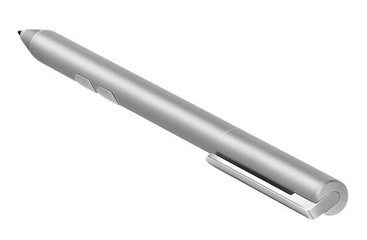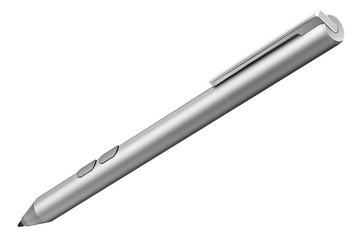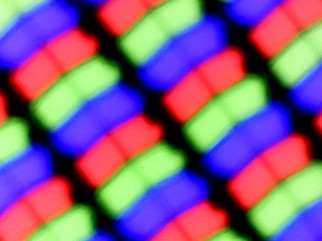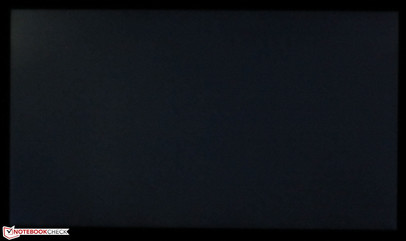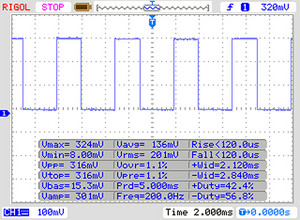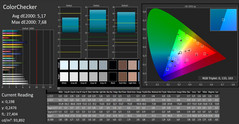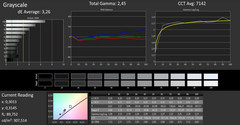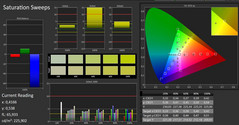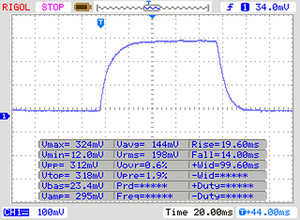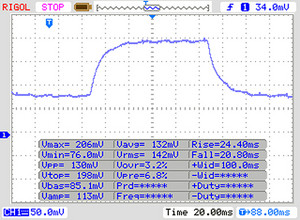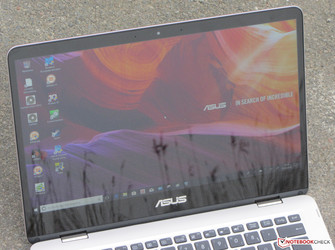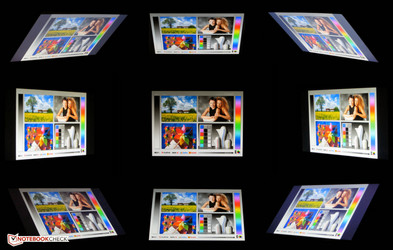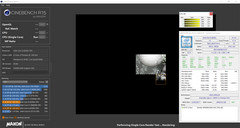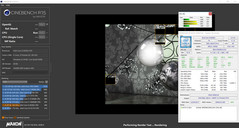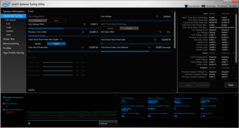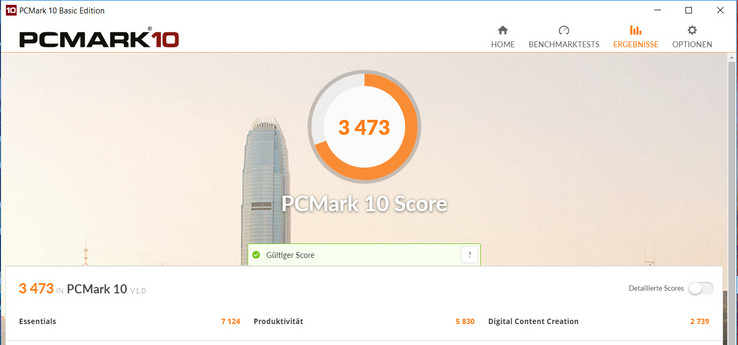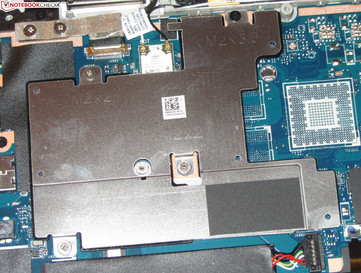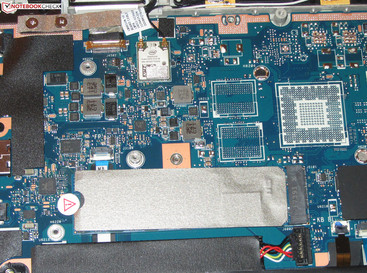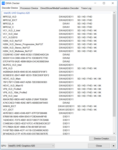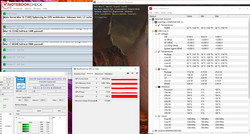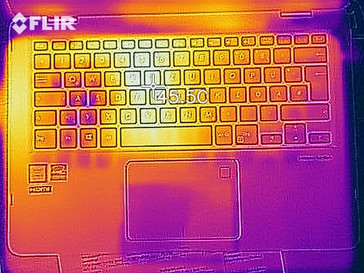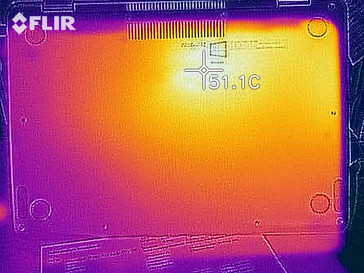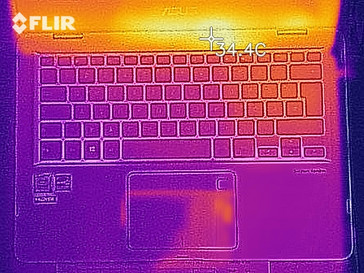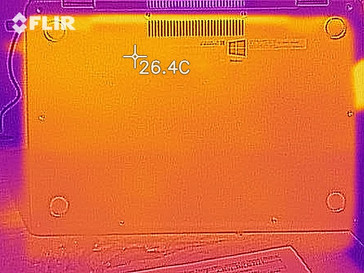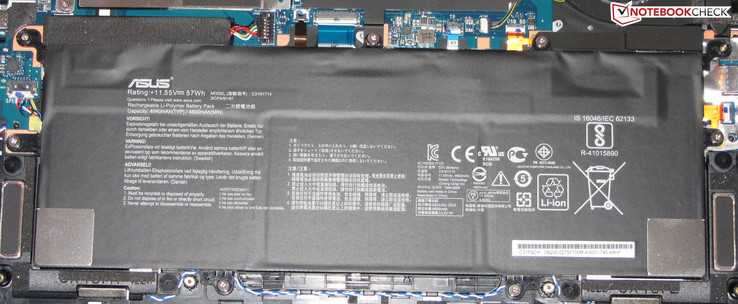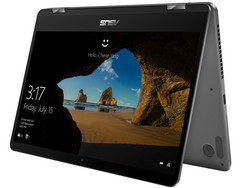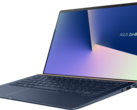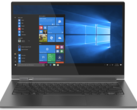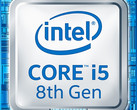Asus ZenBook Flip 14 UX461UA (i5-8250U, SSD, FHD) Convertible Review

The ZenBook Flip 14 UX461UA is a slim and compact convertible with a 14-inch screen. Asus has managed to pack all of the technology into a case that has the dimensions of a 13.3-inch device. The computer is driven by a ULV quad-core processor. The competitors include devices such as the Dell Inspiron 13 5379, the HP Spectre x360 13, and the Lenovo Yoga 920-13IKB.
Case - The ZenBook Flip offers a fashionable metal case
Asus has selected a slim, silver metal case for the ZenBook Flip 14. Only the display bezels are kept in black color. The top of the base unit has a matte finish, and the back of the lid is decorated with a circular brush pattern. The battery is built-in. The Flip 14 does not offer a maintenance hatch and therefore you will have to open the case in order to access the parts inside. More on that later.
The workmanship of the device offers no cause for complaints. The gap widths are correct and there are no noticeable metal protrusions. In terms of stability, the case shows no grave weaknesses. For example, the case can be bent slightly on the left, next to the keyboard and below the touchpad - but this is also the case for most notebooks/convertibles. Even though the base unit can be twisted slightly, this remains within limits. The same can be said about the lid. If you put pressure on the back of the lid, there are some noticeable changes in the image display in some places.
When the lid is opened, the bottom of the lid serves as an additional foot. Then the back area of the base unit is raised and does not touch the surface anymore. The hinges keep the lid tightly in position. You can open the lid with one hand if you use some finger, hand, and arm acrobatics.
Asus has fitted a 14-inch display into a case that has the dimensions of a 13.3-inch device. So the device turns out quite compact and plays at the same level as "real" 13.3-inch devices. The HP Spectre x360 13-ae048ng turns out even significantly slimmer than the competition.
Equipment - Asus only offers standard fare in the Flip 14
Asus does not offer any surprises in terms of the connections. You can connect an external display via HDMI. All three USB ports (2x Type A, 1x Type C) support the USB 3.1 Gen-1 standard. The Type-C port only serves for data transfer, and you cannot charge the battery via Type-C USB, for example. We had expected more here. The price level of the convertible demands for at least one Type-C USB 3.1 Gen-2 port, and it should rather be a Thunderbolt-3 port.
SD Card Reader
Asus does not offer a full SD card reader in the ZenBook, but we have to make do with a microSD reader. The built-in model is not one of the faster ones of its kind. When copying large data blocks, it achieves a maximum transfer rate of 36.5 MB/s. The transfer of 250 JPG image files (around 5 MB each) is performed at a speed of 33.2 MB/s. The HP Spectre x360 13, which is also equipped with a microSD card reader, proves that significantly higher transfer rates would be possible. We are testing the card reader using a reference card (Toshiba Exceria Pro M501 microSDXC 64GB).
| SD Card Reader | |
| average JPG Copy Test (av. of 3 runs) | |
| HP Spectre x360 13-ae048ng (Toshiba Exceria Pro M501 microSDXC 64GB) | |
| Lenovo Yoga 520-14IKB 80X80097GE (Toshiba Exceria Pro SDXC 64 GB UHS-II) | |
| Average of class Convertible (28.1 - 209, n=23, last 2 years) | |
| Asus ZenBook Flip 14 UX461UA (Toshiba Exceria Pro M501 microSDXC 64GB) | |
| Dell Inspiron 13-5379-9573 (Toshiba Exceria Pro SDXC 64 GB UHS-II) | |
| maximum AS SSD Seq Read Test (1GB) | |
| HP Spectre x360 13-ae048ng (Toshiba Exceria Pro M501 microSDXC 64GB) | |
| Average of class Convertible (28.9 - 253, n=22, last 2 years) | |
| Lenovo Yoga 520-14IKB 80X80097GE (Toshiba Exceria Pro SDXC 64 GB UHS-II) | |
| Asus ZenBook Flip 14 UX461UA (Toshiba Exceria Pro M501 microSDXC 64GB) | |
| Dell Inspiron 13-5379-9573 (Toshiba Exceria Pro SDXC 64 GB UHS-II) | |
Communication
The ZenBook Flip does not offer an Ethernet port. Anyone needing such a port will have to use a corresponding USB adapter. The built-in WLAN module uses an Intel chip (Dual Band Wireless-AC 8265), which in addition to the 802.11a/b/g/n WLAN standards also supports the fast ac standard. The transfer rates that we measured under optimal conditions (no additional WLAN devices in close proximity, close distance between notebook and server PC) turned out well.
Webcam
Accessories
As well as the customary information leaflets (warranty information, quick start manual), the box of the convertible also includes a bag.
Maintenance
The ZenBook does not offer a maintenance hatch. In order to access the insides, you will have to remove the bottom of the case. The process is not particularly difficult. In order to do this, you will need to remove all the screws on the bottom of the case. There are no hidden screws underneath the rubber feet. After that, you can remove the case bottom using a spatula. You can access the fan, the SSD, the WLAN module, and the battery. There are no memory slots, but the memory is soldered-in.
Warranty
Asus offers a two-year warranty for the convertible - including pickup service. There is an option to extend the warranty. For example, you have to pay about 90 Euros (~$112) for a three-year warranty. Please see our Guarantees, Return Policies and Warranties FAQ for country-specific information.
Input Devices - The touchscreen of the Asus convertible accepts pen input
Keyboard
The ZenBook Flip is equipped with an illuminated chiclet keyboard. The flat, smooth keys have a short stroke and a clear pressure point. However, the resistance could have been crisper. While typing, the keyboard has a slight give - more in the center than at the edges. Even though this did not interfere much, this should not happen in a device of this price range. The illumination has three brightness levels among which you can choose using two function keys. Overall, Asus delivers a decent keyboard for home use here, but prolific writers should choose another device.
Touchpad
The multi-touch capable ClickPad takes up an area of about 10.5 x 7.3 cm (~4.1 - 2.9 in). This offers a lot of space for navigation using gestures. The smooth surface of the pad makes sliding the fingers easy. The pad has a short stroke and a clear pressure point. There is a fingerprint reader in the top right corner of the ClickPad.
Touchscreen
The touchscreen of the ZenBook supports 10 touch points. It did not give us any problems and reacts promptly to the inputs. The screen can be operated with fingers as well as the Asus Pen, which needs to be purchased separately for about 50 Euros (~$62).
Display - The contrast of the ZenBook Flip 14 display is too low
The 14-inch touchscreen display of the ZenBook Flip has a native resolution of 1920x1080 pixels. The brightness (288 cd/m²) and particularly the contrast (530:1) are too low, considering the price level. We are expecting values beyond 300 cd/m² and 1000:1 here.
Unfortunately, the display uses PWM at a low frequency of 200 Hz to control the brightness at 90% or lower. This can lead to headaches and/or eye problems for sensitive persons.
| |||||||||||||||||||||||||
Brightness Distribution: 90 %
Center on Battery: 302 cd/m²
Contrast: 530:1 (Black: 0.57 cd/m²)
ΔE ColorChecker Calman: 5.17 | ∀{0.5-29.43 Ø4.77}
ΔE Greyscale Calman: 3.26 | ∀{0.09-98 Ø5}
85% sRGB (Argyll 1.6.3 3D)
55% AdobeRGB 1998 (Argyll 1.6.3 3D)
61.8% AdobeRGB 1998 (Argyll 3D)
84.6% sRGB (Argyll 3D)
64.4% Display P3 (Argyll 3D)
Gamma: 2.45
CCT: 7142 K
| Asus ZenBook Flip 14 UX461UA IPS, 1920x1080, 14" | HP Spectre x360 13-ae048ng IPS, 1920x1080, 13.3" | Dell Inspiron 13-5379-9573 IPS, 1920x1080, 13.3" | Lenovo Yoga 920-13IKB-80Y7 IPS, 1920x1080, 13.9" | Lenovo Yoga 520-14IKB 80X80097GE IPS LED, 1920x1080, 14" | |
|---|---|---|---|---|---|
| Display | 13% | -31% | 3% | -34% | |
| Display P3 Coverage (%) | 64.4 | 68.1 6% | 41.2 -36% | 62.5 -3% | 39.76 -38% |
| sRGB Coverage (%) | 84.6 | 99.5 18% | 61.7 -27% | 91.7 8% | 59.3 -30% |
| AdobeRGB 1998 Coverage (%) | 61.8 | 70.2 14% | 42.6 -31% | 64.1 4% | 41.08 -34% |
| Response Times | 18% | -1% | -1% | -5% | |
| Response Time Grey 50% / Grey 80% * (ms) | 44 ? | 36 ? 18% | 45 ? -2% | 46 ? -5% | 47 ? -7% |
| Response Time Black / White * (ms) | 33 ? | 27 ? 18% | 33 ? -0% | 31.6 ? 4% | 34 ? -3% |
| PWM Frequency (Hz) | 200 ? | 25000 ? | 192 ? | 347 ? | |
| Screen | 22% | -10% | -9% | 12% | |
| Brightness middle (cd/m²) | 302 | 311 3% | 274 -9% | 297.9 -1% | 255 -16% |
| Brightness (cd/m²) | 288 | 278 -3% | 272 -6% | 278 -3% | 247 -14% |
| Brightness Distribution (%) | 90 | 82 -9% | 81 -10% | 81 -10% | 83 -8% |
| Black Level * (cd/m²) | 0.57 | 0.2 65% | 0.32 44% | 0.44 23% | 0.21 63% |
| Contrast (:1) | 530 | 1555 193% | 856 62% | 677 28% | 1214 129% |
| Colorchecker dE 2000 * | 5.17 | 3.98 23% | 5.57 -8% | 5.1 1% | 4.5 13% |
| Colorchecker dE 2000 max. * | 7.68 | 8.48 -10% | 13.48 -76% | 11 -43% | 7.21 6% |
| Greyscale dE 2000 * | 3.26 | 5.57 -71% | 4.66 -43% | 6.7 -106% | 2.96 9% |
| Gamma | 2.45 90% | 2.51 88% | 2.53 87% | 2.9 76% | 2.3 96% |
| CCT | 7142 91% | 7810 83% | 7010 93% | 6839 95% | 6965 93% |
| Color Space (Percent of AdobeRGB 1998) (%) | 55 | 64 16% | 39 -29% | 64.1 17% | 38 -31% |
| Color Space (Percent of sRGB) (%) | 85 | 99 16% | 61 -28% | 91.7 8% | 59 -31% |
| Total Average (Program / Settings) | 18% /
20% | -14% /
-13% | -2% /
-5% | -9% /
1% |
* ... smaller is better
Screen Flickering / PWM (Pulse-Width Modulation)
| Screen flickering / PWM detected | 200 Hz | ≤ 90 % brightness setting | |
The display backlight flickers at 200 Hz (worst case, e.g., utilizing PWM) Flickering detected at a brightness setting of 90 % and below. There should be no flickering or PWM above this brightness setting. The frequency of 200 Hz is relatively low, so sensitive users will likely notice flickering and experience eyestrain at the stated brightness setting and below. In comparison: 53 % of all tested devices do not use PWM to dim the display. If PWM was detected, an average of 8083 (minimum: 5 - maximum: 343500) Hz was measured. | |||
The color reproduction in the state of delivery can be called acceptable. We register a DeltaE 2000 color deviation of 5.17. This is not too far from the target range (DeltaE smaller than 3). The display does not suffer from a blue tint. The display is unable to reproduce the AdobeRGB and sRGB color spaces. The coverage rates measure 55% (AdobeRGB) and 85% (sRGB).
You can improve the color reproduction of the display by using the color profile we are offering. However, you need to make sure that you have the same display model (manufacturer + model number) as our test unit. Otherwise the color reproduction can become worse, instead of improving. Often displays from different manufacturers are used within the same notebook model series.
Display Response Times
| ↔ Response Time Black to White | ||
|---|---|---|
| 33 ms ... rise ↗ and fall ↘ combined | ↗ 19 ms rise | |
| ↘ 14 ms fall | ||
| The screen shows slow response rates in our tests and will be unsatisfactory for gamers. In comparison, all tested devices range from 0.1 (minimum) to 240 (maximum) ms. » 89 % of all devices are better. This means that the measured response time is worse than the average of all tested devices (20.2 ms). | ||
| ↔ Response Time 50% Grey to 80% Grey | ||
| 44 ms ... rise ↗ and fall ↘ combined | ↗ 24 ms rise | |
| ↘ 20 ms fall | ||
| The screen shows slow response rates in our tests and will be unsatisfactory for gamers. In comparison, all tested devices range from 0.165 (minimum) to 636 (maximum) ms. » 73 % of all devices are better. This means that the measured response time is worse than the average of all tested devices (31.6 ms). | ||
Asus has equipped the convertible with an IPS panel whose viewing angles are stable. You can read the display from any position. Outdoors, you can only use the computer when the sun is not too bright. There are the additional disadvantages of the reflective display surface.
Performance - Asus has equipped the ZenBook convertible with mid-range hardware
With the ZenBook Flip 14, Asus delivers a 14-inch convertible which offers more than enough computing power for applications from the office and internet areas. Our test unit can be purchased for about 950 to 1,000 Euros (~$1,178 - 1,240; The Asus ZenBook Flip 14 UX461UA is available for about $900 in the US). Other model variants are also available.
Processor
The ZenBook is driven by an Intel Core i5-8250U (Kaby Lake Refresh) quad-core processor. This is a mid-range CPU that strikes a good figure in all application areas. The built-in ULV processor (TDP: 15 watts) supports Hyperthreading, which means that two threads per core can run simultaneously. It operates at a basic clock speed of 1.6 GHz which can be increased up to 3.4 GHz via Turbo.
The processor runs through our multithread CPU tests at 1.3 to 3.4 GHz in mains operation. The single-thread tests are mostly run at 3.4 GHz. At times, one core is throttled down to 2.4 to 2.8 GHz. In battery operation, Turbo is not used, and the CPU tests run at 1.4 to 1.6 GHz (single thread) and 1.8 GHz (multithread).
We test whether the Turbo can also be used continuously in mains operation by running the multithread test of Cinebench R15 for about 30 minutes in a continuous loop. From the first to the second run, the result drops by about 5%. In successive runs, we also observe a drop - however, then the results drop considerably slower. In other words, the average Turbo speed drops with each successive run.
The results in the CPU tests we ran remain on a normal level for the processor used here. In the multithread applications, the Turbo speed fluctuates significantly. This does not surprise us, since the cooling options are limited in a slim and compact convertible such as the ZenBook.
The additional cost for a ZenBook model with a Core-i7-8550U processor would not be worthwhile for most users. First, the moderate performance gain would be outweighed by a significant premium and second, the Core i7 would not be able to use its full performance, or only use it for a very short time as is the case here.
| Geekbench 3 | |
| 32 Bit Multi-Core Score | |
| Average Intel Core i5-8250U (10893 - 13553, n=18) | |
| Asus ZenBook Flip 14 UX461UA | |
| 32 Bit Single-Core Score | |
| Asus ZenBook Flip 14 UX461UA | |
| Average Intel Core i5-8250U (3148 - 3503, n=18) | |
| Geekbench 4.0 | |
| 64 Bit Multi-Core Score | |
| Average of class Convertible (23833 - 37474, n=3, last 2 years) | |
| Average Intel Core i5-8250U (10751 - 13486, n=19) | |
| Asus ZenBook Flip 14 UX461UA | |
| 64 Bit Single-Core Score | |
| Average of class Convertible (6365 - 8254, n=3, last 2 years) | |
| Asus ZenBook Flip 14 UX461UA | |
| Average Intel Core i5-8250U (3924 - 4243, n=19) | |
| Geekbench 4.4 | |
| 64 Bit Multi-Core Score | |
| Average Intel Core i5-8250U (11269 - 14228, n=25) | |
| Asus ZenBook Flip 14 UX461UA | |
| 64 Bit Single-Core Score | |
| Asus ZenBook Flip 14 UX461UA | |
| Average Intel Core i5-8250U (3453 - 4330, n=25) | |
| JetStream 1.1 - Total Score | |
| Lenovo Yoga 920-13IKB-80Y7 (40.15063.674.0) | |
| HP Spectre x360 13-ae048ng | |
| Asus ZenBook Flip 14 UX461UA (Edge 41) | |
| Average Intel Core i5-8250U (151.5 - 256, n=78) | |
| Lenovo Yoga 520-14IKB 80X80097GE (Edge) | |
| Dell Inspiron 13-5379-9573 | |
System Performance
The combination of Core-i5 processor, working memory running in dual-channel mode, and Solid-State Disk ensures a smooth running system. We did not encounter any problems. The computer has more than enough performance for applications from the office and internet areas. The very good results in the PC-Mark benchmarks confirm this. An increase in performance would not be possible, since Asus has already maxed everything out.
| PCMark 7 Score | 5667 points | |
| PCMark 8 Home Score Accelerated v2 | 3660 points | |
| PCMark 8 Creative Score Accelerated v2 | 4666 points | |
| PCMark 8 Work Score Accelerated v2 | 4700 points | |
| PCMark 10 Score | 3473 points | |
Help | ||
Storage Solution
Asus has equipped the ZenBook with a SATA-III SSD from SanDisk. This is a model in the M.2-2280 format, which offers a total capacity of 256 GB. Of that, about 205 GB are available to the user at the time of delivery. The remaining storage space is used by the Windows installation and the recovery partition. The transfer rates turn out to be good.
According to the Asus website, there are also ZenBook models that are equipped with NVMe SSDs. So there should be an option to replace the SSD used in our test unit with an NVMe model. These Solid-State Disks run at considerably higher transfer rates, since they are connected via PCI Express x4 3.0.
| Asus ZenBook Flip 14 UX461UA SanDisk SD8SN8U256G1002 | HP Spectre x360 13-ae048ng Toshiba NVMe THNSN51T02DUK | Dell Inspiron 13-5379-9573 Micron 1100 MTFDDAV256TBN | Lenovo Yoga 920-13IKB-80Y7 Samsung PM961 MZVLW256HEHP | Lenovo Yoga 520-14IKB 80X80097GE Intel SSD 600p SSDPEKKW256G7 | Average SanDisk SD8SN8U256G1002 | |
|---|---|---|---|---|---|---|
| CrystalDiskMark 3.0 | 108% | -19% | 200% | 90% | 4% | |
| Read Seq (MB/s) | 414.1 | 919 122% | 447.9 8% | 2070 400% | 1171 183% | 457 ? 10% |
| Write Seq (MB/s) | 435.6 | 776 78% | 304.8 -30% | 1125 158% | 605 39% | 438 ? 1% |
| Read 512 (MB/s) | 290.2 | 620 114% | 293.7 1% | 1252 331% | 720 148% | 301 ? 4% |
| Write 512 (MB/s) | 302.7 | 575 90% | 157 -48% | 832 175% | 472.8 56% | 308 ? 2% |
| Read 4k (MB/s) | 28.74 | 45.99 60% | 14.03 -51% | 56.2 96% | 35.92 25% | 28.2 ? -2% |
| Write 4k (MB/s) | 52.5 | 138.1 163% | 63.3 21% | 142.4 171% | 132.5 152% | 53 ? 1% |
| Read 4k QD32 (MB/s) | 285.7 | 542 90% | 165.9 -42% | 432.9 52% | 290.1 2% | 318 ? 11% |
| Write 4k QD32 (MB/s) | 179.6 | 437.3 143% | 155.1 -14% | 573 219% | 389.6 117% | 189.3 ? 5% |
Graphics Card
Intel's UHD Graphics 620 graphics core handles the graphics output. The GPU supports DirectX 12 and runs at speeds of between 300 and 1100 MHz. The results in the 3DMark benchmarks remain on a normal level for this GPU. It benefits from the working memory running in dual-channel mode, which makes better use of the graphics core, so it can provide a higher performance.
| 3DMark 06 Standard Score | 10737 points | |
| 3DMark 11 Performance | 1973 points | |
| 3DMark Ice Storm Standard Score | 67355 points | |
| 3DMark Cloud Gate Standard Score | 8245 points | |
| 3DMark Fire Strike Score | 1088 points | |
| 3DMark Time Spy Score | 419 points | |
Help | ||
Gaming Performance
The CPU-GPU combination of the ZenBook Flip can bring some games smoothly to the screen. However, you must limit yourself to low resolutions and low quality settings. And this goes only for games that have moderate demands on the hardware. Power hungry games such as "Final Fantasy XV" cannot be played under any circumstances. Thanks to the working memory running in dual-channel mode, the frame rates turn out higher than in comparable devices whose memory runs in single-channel mode.
| low | med. | high | ultra | |
|---|---|---|---|---|
| Tomb Raider (2013) | 89.9 | 45.6 | 30.5 | 13.5 |
| BioShock Infinite (2013) | 60.3 | 31.2 | 27.1 | 9.8 |
| Rise of the Tomb Raider (2016) | 17.9 | 10.9 | 6.1 | 3 |
Emissions
Noise Emissions
The fan of the convertible does not produce a particularly high noise level. During idle operation, it is mostly silent or runs at a very low speed. Under load, it does not rev up excessively. During the stress test, we measured a noise level of 35.9 dB(A).
Unfortunately, the ZenBook produces some background noises: If you listen closely, you can hear a constant electronic crackling with varying intensity coming from inside. However, while idling or under low loads, you need to put your ear close to the device in order to hear the crackling at all. But under load, you can sometimes even still hear it clearly while the fan is running - for example, while running the Cinebench benchmark.
Noise level
| Idle |
| 30.4 / 30.4 / 32 dB(A) |
| Load |
| 31.7 / 35.9 dB(A) |
 | ||
30 dB silent 40 dB(A) audible 50 dB(A) loud |
||
min: | ||
| Asus ZenBook Flip 14 UX461UA i5-8250U, UHD Graphics 620 | HP Spectre x360 13-ae048ng i5-8550U, UHD Graphics 620 | Dell Inspiron 13-5379-9573 i5-8250U, UHD Graphics 620 | Lenovo Yoga 920-13IKB-80Y7 i5-8550U, UHD Graphics 620 | Lenovo Yoga 520-14IKB 80X80097GE i5-7200U, HD Graphics 620 | |
|---|---|---|---|---|---|
| Noise | 2% | 1% | 4% | -2% | |
| off / environment * (dB) | 30.4 | 30.13 1% | 30.1 1% | 28 8% | 30.3 -0% |
| Idle Minimum * (dB) | 30.4 | 30.13 1% | 30.1 1% | 28 8% | 30.3 -0% |
| Idle Average * (dB) | 30.4 | 30 1% | 30.1 1% | 28.8 5% | 30.3 -0% |
| Idle Maximum * (dB) | 32 | 30.13 6% | 30.1 6% | 30.3 5% | 30.3 5% |
| Load Average * (dB) | 31.7 | 33.4 -5% | 33 -4% | 34.5 -9% | 37.2 -17% |
| Load Maximum * (dB) | 35.9 | 33 8% | 35 3% | 34.3 4% | 35.2 2% |
* ... smaller is better
Temperature
The ZenBook runs through our stress test (Prime95 and FurMark run for at least one hour) in the same way in mains and battery operation. The processor begins the test at 1.3 - 1.6 GHz, and then the speed drops to 1.2 - 1.4 GHz. At the beginning of the test, the graphics core runs at 700 - 900 MHz, and later the speed levels out at 800 MHz.
The heat development of the convertible remains within limits. During the stress test, the 40-degree Celsius mark (104 °F) is only exceeded at two measurement points.
(+) The maximum temperature on the upper side is 39 °C / 102 F, compared to the average of 35.4 °C / 96 F, ranging from 19.6 to 60 °C for the class Convertible.
(-) The bottom heats up to a maximum of 45.6 °C / 114 F, compared to the average of 36.8 °C / 98 F
(+) In idle usage, the average temperature for the upper side is 22 °C / 72 F, compared to the device average of 30.3 °C / 87 F.
(+) The palmrests and touchpad are cooler than skin temperature with a maximum of 30.4 °C / 86.7 F and are therefore cool to the touch.
(-) The average temperature of the palmrest area of similar devices was 27.9 °C / 82.2 F (-2.5 °C / -4.5 F).
| Asus ZenBook Flip 14 UX461UA i5-8250U, UHD Graphics 620 | HP Spectre x360 13-ae048ng i5-8550U, UHD Graphics 620 | Dell Inspiron 13-5379-9573 i5-8250U, UHD Graphics 620 | Lenovo Yoga 920-13IKB-80Y7 i5-8550U, UHD Graphics 620 | Lenovo Yoga 520-14IKB 80X80097GE i5-7200U, HD Graphics 620 | |
|---|---|---|---|---|---|
| Heat | -18% | -35% | -1% | -3% | |
| Maximum Upper Side * (°C) | 39 | 46.5 -19% | 43.2 -11% | 44.4 -14% | 35 10% |
| Maximum Bottom * (°C) | 45.6 | 46.5 -2% | 57.8 -27% | 42.8 6% | 29.6 35% |
| Idle Upper Side * (°C) | 23.3 | 29.6 -27% | 35.7 -53% | 22.2 5% | 28.9 -24% |
| Idle Bottom * (°C) | 23.1 | 28.4 -23% | 34.6 -50% | 23.4 -1% | 30.5 -32% |
* ... smaller is better
Speakers
The stereo speakers are placed at the bottom of the device. They produce a pleasing, full sound which you can listen to for prolonged periods without any trouble. However, the maximum volume is rather too low.
Asus ZenBook Flip 14 UX461UA audio analysis
(-) | not very loud speakers (61.4 dB)
Bass 100 - 315 Hz
(±) | reduced bass - on average 11.6% lower than median
(±) | linearity of bass is average (14.8% delta to prev. frequency)
Mids 400 - 2000 Hz
(+) | balanced mids - only 1.7% away from median
(+) | mids are linear (3.1% delta to prev. frequency)
Highs 2 - 16 kHz
(+) | balanced highs - only 1.6% away from median
(+) | highs are linear (4.8% delta to prev. frequency)
Overall 100 - 16.000 Hz
(+) | overall sound is linear (13.9% difference to median)
Compared to same class
» 20% of all tested devices in this class were better, 4% similar, 77% worse
» The best had a delta of 6%, average was 20%, worst was 57%
Compared to all devices tested
» 15% of all tested devices were better, 4% similar, 81% worse
» The best had a delta of 4%, average was 24%, worst was 134%
Apple MacBook 12 (Early 2016) 1.1 GHz audio analysis
(+) | speakers can play relatively loud (83.6 dB)
Bass 100 - 315 Hz
(±) | reduced bass - on average 11.3% lower than median
(±) | linearity of bass is average (14.2% delta to prev. frequency)
Mids 400 - 2000 Hz
(+) | balanced mids - only 2.4% away from median
(+) | mids are linear (5.5% delta to prev. frequency)
Highs 2 - 16 kHz
(+) | balanced highs - only 2% away from median
(+) | highs are linear (4.5% delta to prev. frequency)
Overall 100 - 16.000 Hz
(+) | overall sound is linear (10.2% difference to median)
Compared to same class
» 7% of all tested devices in this class were better, 2% similar, 91% worse
» The best had a delta of 5%, average was 18%, worst was 53%
Compared to all devices tested
» 4% of all tested devices were better, 1% similar, 94% worse
» The best had a delta of 4%, average was 24%, worst was 134%
Frequency comparison (checkboxes selectable!)
Power Management - The ZenBook uses little power and has good endurance
Power Consumption
The ZenBook Flip does not reveal any abnormalities in terms of its power needs. Over the whole load range, the power consumption remains on a normal level for the built-in hardware. During idle operation, we measure a maximum power consumption of 11 watts. During the stress test, this value rises up to 36.4 watts. The power supply is rated at 45 watts.
| Off / Standby | |
| Idle | |
| Load |
|
Key:
min: | |
| Asus ZenBook Flip 14 UX461UA i5-8250U, UHD Graphics 620 | HP Spectre x360 13-ae048ng i5-8550U, UHD Graphics 620 | Dell Inspiron 13-5379-9573 i5-8250U, UHD Graphics 620 | Lenovo Yoga 920-13IKB-80Y7 i5-8550U, UHD Graphics 620 | Lenovo Yoga 520-14IKB 80X80097GE i5-7200U, HD Graphics 620 | |
|---|---|---|---|---|---|
| Power Consumption | 5% | 1% | 4% | 9% | |
| Idle Minimum * (Watt) | 3.3 | 3.2 3% | 3.2 3% | 3.1 6% | 3.5 -6% |
| Idle Average * (Watt) | 6.3 | 6 5% | 5.9 6% | 6.6 -5% | 6.2 2% |
| Idle Maximum * (Watt) | 11 | 9.2 16% | 8.8 20% | 7 36% | 7.4 33% |
| Load Average * (Watt) | 30 | 29.5 2% | 31.2 -4% | 35.2 -17% | 32.2 -7% |
| Load Maximum * (Watt) | 35.4 | 35.6 -1% | 42.2 -19% | 34.6 2% | 26.4 25% |
* ... smaller is better
Battery Life
The ZenBook Flip 14 does not lack endurance. In our practically relevant WLAN test, the Convertible achieves a runtime of 9:26 h. Here, we simulate the load while opening websites via a script. The "Balanced" power profile is active, the power saving functions are deactivated, and the display brightness is lowered to about 150 cd/m². The 14-incher lasts for 8:33 h in our video test, where we run the short film "Big Buck Bunny" (H.264-coding, 1920x1080 pixels) in a constant loop. The Wi-Fi module as well as the power saving functions are deactivated, and the display brightness is set at about 150 cd/m².
| Asus ZenBook Flip 14 UX461UA i5-8250U, UHD Graphics 620, 57 Wh | HP Spectre x360 13-ae048ng i5-8550U, UHD Graphics 620, 60 Wh | Dell Inspiron 13-5379-9573 i5-8250U, UHD Graphics 620, 42 Wh | Lenovo Yoga 920-13IKB-80Y7 i5-8550U, UHD Graphics 620, 70 Wh | Lenovo Yoga 520-14IKB 80X80097GE i5-7200U, HD Graphics 620, 53 Wh | Average of class Convertible | |
|---|---|---|---|---|---|---|
| Battery runtime | 45% | -29% | 26% | 5% | 29% | |
| Reader / Idle (h) | 18.9 | 15.3 -19% | 27.6 46% | 14.8 -22% | 25.1 ? 33% | |
| H.264 (h) | 8.6 | 17.8 107% | 10 16% | 15.2 ? 77% | ||
| WiFi v1.3 (h) | 9.4 | 8.8 -6% | 5.4 -43% | 11.4 21% | 8.3 -12% | 11.2 ? 19% |
| Load (h) | 2.1 | 2.8 33% | 1.6 -24% | 2.3 10% | 2.9 38% | 1.793 ? -15% |
Verdict
Pros
Cons
With the ZenBook Flip 14, Asus has a convertible in its offerings whose 14-inch screen has been fitted into a case that has the dimensions of a 13.3-inch notebook. So this is a slim and compact device. The computer is run by a ULV quad-core processor which offers more than enough processing power for application from the office or internet areas.
A Solid-State Disk ensures a smooth running system. This could be replaced by an NVMe model if necessary. However, in order to do this, you would need to open the case of the notebook.
Despite its price of almost 1000 Euros (~$1240), the ZenBook Flip 14 still leaves room for improvement.
The battery life turns out very good. This is accompanied by a decent keyboard, which fulfills the demands of home usage. The keyboard illumination is also a positive. The display does not trigger any storm of enthusiasm. The brightness and particularly the contrast would need to be higher - the price level of the convertible demands it.
We see the Type-C USB 3.1 Gen-1 connection as unsuitable, since it can only be used for data transfer. We would have at least expected that the battery of the notebook could be charged via Type-C USB. After all, this is a mobile device. In principle, Asus should have put in a Thunderbolt-3 connection. In addition, Asus has only equipped the ZenBook Flip with a microSD card reader that does its work rather leisurely.
Finally, we should mention the electronic crackling of our test unit, which is produced by the convertible in varying intensity. This also should not happen in a device of this price range.
Asus ZenBook Flip 14 UX461UA
- 03/26/2018 v6 (old)
Sascha Mölck


